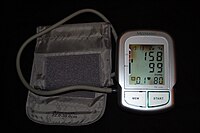
Photo from wikipedia
Abstract Previous studies have indicated that some food items and nutrients are associated with uric acid metabolism in humans. However, little is known about the role of dietary patterns in… Click to show full abstract
Abstract Previous studies have indicated that some food items and nutrients are associated with uric acid metabolism in humans. However, little is known about the role of dietary patterns in hyperuricaemia. We designed this case–control study to evaluate the associations between dietary patterns and newly diagnosed hyperuricaemia in Chinese adults. A total of 1422 cases and 1422 controls were generated from 14 538 participants using the 1:1 ratio propensity score matching methods. Dietary intake was assessed using a validated self-administered FFQ. Dietary patterns were derived by factor analysis. Hyperuricaemia was defined as concentrations of serum uric acid higher than 7 mg/dl (416·5 μmol/l) for men and 6 mg/dl (357 μmol/l) for women. Three dietary patterns were derived by factor analysis: sweet pattern; vegetable pattern; animal foods pattern. The animal foods pattern characterised by higher intake of an animal organ, seafood and processed meat products was associated with higher prevalence of newly diagnosed hyperuricaemia (P for trend<0·01) after adjustment. Compared with the participants in the lowest quartile of the animal foods pattern, the OR of newly diagnosed hyperuricaemia in the highest quartile was 1·50 (95 % CI 1·20, 1·87). The other two dietary patterns were not associated with the prevalence of newly diagnosed hyperuricaemia after adjustment. In conclusion, a diet rich in animal organ, seafood and processed meat products is associated with higher prevalence of newly diagnosed hyperuricaemia in a Chinese population. Further cohort studies and randomised controlled trials are required to clarify these findings.
Journal Title: British Journal of Nutrition
Year Published: 2018
Link to full text (if available)
Share on Social Media: Sign Up to like & get
recommendations!